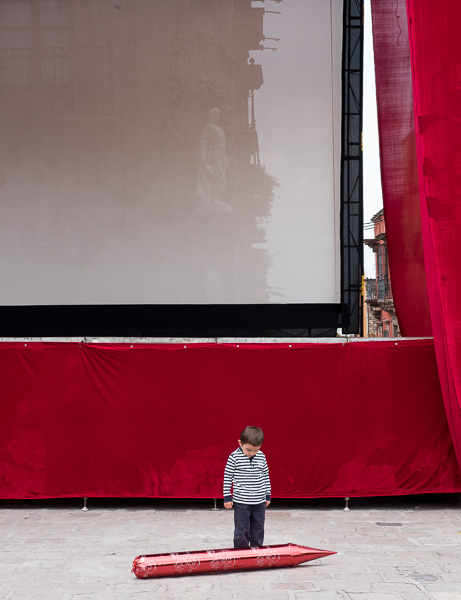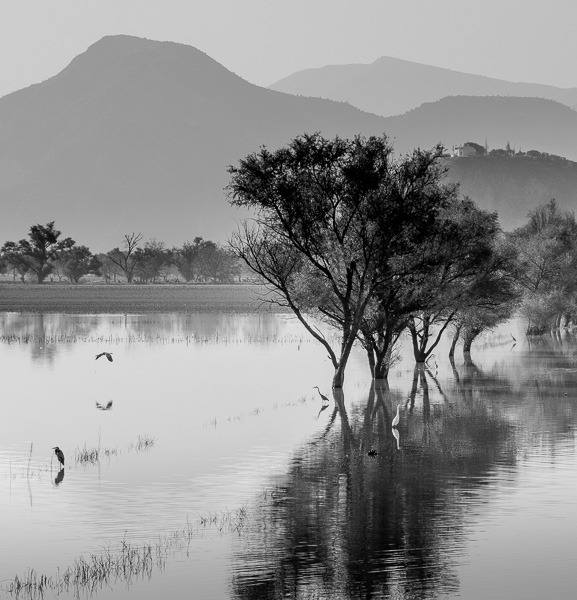What Are the Rules?
By Harold Merklinger
Mark Schacter’s essay on these pages titled Am I a Photographic Cheat? invites answers.
Photography, like many aspects of life, is a game – but we don’t always know the rules.
The mere notion of “cheating” implies that some set of rules exists. As a physicist I’ll offer that photographic technology has no choice but to obey the laws of physics. Whatever works works; whatever fails fails. It’s pretty hard to cheat Physics! But there is usually a human aspect to photography: the photographer and the viewer. Indeed the subset of photography discussed on The Luminous Landscape pretty much sets a high value on the human element whether it’s the ergonomics of the tools used or the assessment of the image produced. Physics has little to do with the human aspects apart from the fact that physics plays a role in keeping the humans alive. Thus I would argue that any rules associated with photography somehow must derive primarily from those humans rather than any natural order of the universe.
I have tried over the years to find natural rules governing photography: rules that derive from nature, whether that’s physics, chemistry, or the history of the earth and its creatures. I have found few. With some aspects of life, there are indeed natural rules: for many activities of any species, the individual must survive. Not true for artistic endeavours; there are many examples where the artist succeeded – in the sense that his work was valued by others – only after his death. But his work obviously did survive, so we do have one natural rule: a photograph must survive long enough for other people to see it and appreciate it. The artist does have to survive long enough to produce his art and that’s about it. And there’s another implicit rule: the art or photograph must be visible. Latent images aside, there is no such thing as an invisible photograph.
What about rules of composition or perspective? Sorry, I see so no naturally derived rules there. One can justify some of these rules by analogy with natural systems, but there are no mandatory rules here. Whatever happens, happens. Tonality? Well, as we have already discussed, the image must be visible, so there must be some tonality. Colour? There will always be colour of some sort – even in black and white photography. But there is a long history to classic art, and conventions have developed that govern many generalities with respect to illustration.
To discover more rules for photography then, we’ll have to look to the human species. And here we’ll find rich pickings. I’d venture to say that every one of us has his own rule set governing what is and what isn’t a good photograph. The amateur photographer is free to make up his own set of rules, follow them, and judge his own work etc. as he likes. The professional photographer, on the other hand, is often playing by the client’s rules. The professional needs other people to buy his work. The amateur does not need to know what game (set of rules) he is playing, whereas the professional generally does. Of course when the amateur enters his work in a contest, he would be wise to know the rules if he desires to win. I suggest, however, even in contests with detailed explicit rules, there are many more rules that lurk in the minds of the judges.
So, what games are we playing? I can’t speak for everyone, but here are some of mine. I tend not to value photographs that have high initial impact – one says “Wow!” – but once you have seen it, you’ve seen it. I understand nevertheless that advertising needs that sort of photograph. I like complex photos with pictures within pictures. After studying the image you say “Wow, that photo has a lot of stories associated with it!” I like photos with emotional impact, but that emotion may not be evident until one discovers it. I tend to like ‘correct’ conventional perspective, but it is not always necessary. And sometimes things just ‘look wrong’ even when the perspective is ‘correct’. I like pictures that bring me back to look again, and again.

The Mythical Halifax Convention Center.
Two infra-red exposures taken with a Leica M8 and 28/2.8 lens, stitched together with perspective adjustments to allow them to merge well. One cloud added independently and automatically by Photoshop CS5. The alternative was to crop out a portion of the building at right. Am I cheating? Not by my rules, but I did break with several of my usual practices. In my view the false cloud neither adds substantively nor detracts from the image, whereas loss of a portion of the building would definitely detract. I did try a somewhat different perspective treatment to avoid filling in sky, but it just didn’t look right.
And then there are other games/rules that seem to be bothering Mark Schacter: What degree of after-exposure “manipulation” is OK? I don’t believe there are any natural rules here: whatever is possible is possible. The rules may be quite different in different types of photography, however. For forensic purposes the rules can be quite rigid. The photograph must honestly portray the facts. Yet the photo might be strongly manipulated to bring out low contrast detail that reveals those facts. For illustrating a fictional story there’s probably lots of room for imaginative distortion. My own basic rule regarding manipulation is that whatever is done, it should not be obvious that it has been done. I tend to prefer global adjustments that affect the entire image over selecting and altering just a portion of the image. But even local adjustments are OK so long as they are not obvious. But that’s just my rule; it doesn’t have to apply to everyone. And there are lots of famous photographs that have obviously been manipulated.
Regarding manipulation, it is important to understand that it is impossible not to manipulate a photograph. The lens manipulates, the sensor or medium manipulates, the camera manipulates. the developer (chemical or computer-based) manipulates, the printer (machine or human) manipulates, the paper (or screen) manipulates, and even the light used for viewing manipulates. Beyond that, even the human eye and brain extensively manipulate the image we “see”. So, Mark, you’re not a cheat by my rules either.
This brings us to the classic questions of “What is an image?” and “What is a photograph?” The French painter René Magritte did several images showing a smoker’s pipe along with the words “Ceci n’est pas une pipe” (This is not a pipe). His point is that a painting of a pipe is not a real pipe: you cannot use the image of a pipe to smoke tobacco. Similarly, one cannot use a photograph of a doghouse to protect a dog from the elements. Well, you could try, but it would probably not be very successful. Whether a painting or a photograph, an image is necessarily an abstraction. It may be related to a real object or set of objects, but it will not possess all the characteristics of that object or set of objects. In a sense, a photograph (or drawing, or painting) is a fake to begin with and we must accept that. And yet it may also be a genuine work of art, or decidedly not. Which it is and how successful it is, depends upon the rule set (the game) that applies.
I would argue that an image, whether a painting, a drawing or a photograph, is a graphic portrayal of some object, scene, story, or idea that conveys some message to the viewer through the sense of sight. Even a drawing or painting may involve some degree of technical assistance in its preparation, be it a measure taken by means of a brush handle and thumb, a projected image, a sketch or even a photograph. It may also be entirely the imagination of the artist. A photograph necessarily relies heavily on technical assistance, but also involves some degree of human intervention. A human probably at least determined where to point the camera and when to push the button. A photograph necessarily requires some scene or object to serve as its origin. That origin does not need to be identifiable, but it usually helps to have at least a few clues. From there on, it depends what photographic game the photographer chooses to play. Is the scene identifiable? Is there some action or situation that is to be portrayed? Is it a play on colour and/or light? How much detail or lack thereof is appropriate? Am I satisfying just myself, or do I have a viewer or audience in mind? Does the viewer understand or need to understand my intent? The answers will vary.
I imagine Mark Schacter’s conversation going something like this:
PERSON 1: Did you take those with a digital camera?
PERSON 2: Yes. I use a digital camera.
PERSON 1: So do you play around with your images?
PERSON 2: All photographs have been manipulated; one can’t avoid that.
PERSON 1: (with furrowed brow): Isn’t that sort of cheating?
PERSON 2: In order to cheat, there must be rules. What are your rules?
PERSON 1: Gee, I don’t know. I never thought about it. Give me an example.
PERSON2: In order to create a photograph, I had to use a camera and then somehow move what the camera recorded to the screen or sheet of paper that you saw. I simply did that the best way I know how.
PERSON 1: What if you had used a real camera? One that uses film.
PERSON 2: It doesn’t make any difference; I still have to process that latent image and transfer it to a screen or piece of paper so that others can see it. There’s still lots of opportunity for me to influence the final outcome.
PERSON 1: Why don’t my pictures look like yours?
PERSON 2: Probably, just because you don’t yet understand what is possible or why certain techniques and changes can make a picture look better.
PERSON 1: Can’t the camera do that for me automatically?
PERSON 2: The camera doesn’t know what you are trying to do. Modern cameras are quite smart, but they can only make a guess about what you are trying to do.
PERSON 1: You said something about rules. What are some other rules?
PERSON 2: Well, Photography is kind of like sports. There are many sports: individual sports, team sports, indoor sports, beach sports et cetera. Each sport or game has its own set of rules. And there’s always room to invent a new sport. I could declare a new genre of photography where the only rule is to break as many rules from other forms of photography as possible.
PERSON 1: How do I know which photographic sport I should play?
PERSON 2: You’ll just have to try a few of them and find out which ones you enjoy or do well at and which ones you don’t.
PERSON 1: Where can I find the rules for all the forms of photography.
PERSON 2: That’s one of the harder things to do. Unlike football where the various forms of the game have well-defined rulebooks, photography is rather less well-defined. About the best you can do is to talk to lots of successful photographers and try to find out from them. There are schools that will teach you most of the basics, but like any school, they can’t teach you everything. There are also lots of books that explain many of the important issues. Some things you just have to learn on your own. What you learn as an individual is what will make your photographs special. And remember too, that even a well-paid successful photographer may not fully and consciously understand why he is so successful. Just like in sports, some people just seem to know better than others what to do in any particular situation. The rules change over time too.
PERSON 1: I didn’t know photography was so difficult.
PERSON 2: Just about anybody can play the game, but not everyone does well at it. Some people seem to have a natural aptitude for it; other people have to work at it. Just do it. If you have stuck with me this far, you are probably serious enough about it to do well!

Peggy Sue’s Used Kruisers.
Here I will readily admit to cheating: I removed the utility wires. The resulting image is indeed less cluttered, but in 50 or 100 years – should the image last that long – people will say “An image from this period should show above-ground utility wires; it’s obviously been manipulated.” And, if you look closely you will find shadows of the wires! I broke my own rule! Sony Alpha 100, Minolta 35-105 lens at 50 mm.
Harold M. Merklinger
February, 2012
Read this story and all the best stories on The Luminous Landscape
The author has made this story available to Luminous Landscape members only. Upgrade to get instant access to this story and other benefits available only to members.
Why choose us?
Luminous-Landscape is a membership site. Our website contains over 5300 articles on almost every topic, camera, lens and printer you can imagine. Our membership model is simple, just $2 a month ($24.00 USD a year). This $24 gains you access to a wealth of information including all our past and future video tutorials on such topics as Lightroom, Capture One, Printing, file management and dozens of interviews and travel videos.
- New Articles every few days
- All original content found nowhere else on the web
- No Pop Up Google Sense ads – Our advertisers are photo related
- Download/stream video to any device
- NEW videos monthly
- Top well-known photographer contributors
- Posts from industry leaders
- Speciality Photography Workshops
- Mobile device scalable
- Exclusive video interviews
- Special vendor offers for members
- Hands On Product reviews
- FREE – User Forum. One of the most read user forums on the internet
- Access to our community Buy and Sell pages; for members only.













